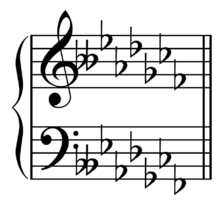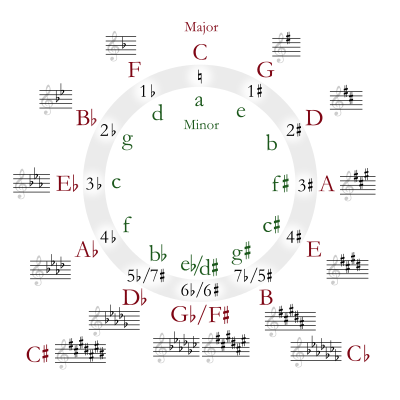Theoretical key


In music theory, a theoretical key or "impossible key" is a key whose key signature has at least one double-flat or double-sharp.
Double-flats and double-sharps are frequently used as accidentals, but placing them in the key signature (in music that uses equal temperament) make the music generally impractical to read.
For example, the key of F♭ major is a key of this type, because its corresponding key signature would contain a B![]() (on its subdominant degree). An equal-tempered scale of F♭ major comprises the same pitches as the E major scale, so that the two scales sound exactly the same; such key pairs are said to be enharmonically equivalent. Consequently, the theoretical key of F♭ major is usually notated as E major.
(on its subdominant degree). An equal-tempered scale of F♭ major comprises the same pitches as the E major scale, so that the two scales sound exactly the same; such key pairs are said to be enharmonically equivalent. Consequently, the theoretical key of F♭ major is usually notated as E major.
| E major: | E | F♯ | G♯ | A | B | C♯ | D♯ |
| F♭ major: | F♭ | G♭ | A♭ | B | C♭ | D♭ | E♭ |
Even when enharmonic equivalence is not resorted to, it is more common to use either no key signature or one with single-flats and to provide accidentals as needed for the B![]() s, than to incorporate double-flats into the key signature. Nevertheless, examples of the latter can be found (see below).
s, than to incorporate double-flats into the key signature. Nevertheless, examples of the latter can be found (see below).
Enharmonic equivalence

While a piece of Western music generally has a home key, a passage within it may modulate to another key, which is usually closely related to the home key (in the Baroque and early Classical eras), that is, close to the original around the circle of fifths. When the key is near the top of the circle (a key signature of zero or few accidentals), the notation of both keys is straightforward. But if the home key is near the bottom of the circle (a key signature of many accidentals), and particularly if the new key is on the opposite side (in the late Classical and Romantic eras), it becomes necessary to consider enharmonic equivalence (if double accidentals are to be avoided).
In each of the bottom three places on the circle of fifths the two enharmonic equivalents can be notated entirely with single accidentals and so do not classify as 'theoretical keys':
| Major (minor) | Key signature | Major (minor) | Key signature | |
|---|---|---|---|---|
| B (g♯) | 5 sharps | C♭ (a♭) | 7 flats | |
| F♯ (d♯) | 6 sharps | G♭ (e♭) | 6 flats | |
| C♯ (a♯) | 7 sharps | D♭ (b♭) | 5 flats |
The need to consider theoretical keys
However, when a relative key ascends the opposite side of the circle from its home key, then theory suggests that double-sharps and double-flats would have to be incorporated into the notated key signature. The following keys (six of which are the parallel major/minor keys of those above) would require up to three double-sharps or double-flats:
| Key | Key Signature | Relative key |
|---|---|---|
| D♭ minor (= C♯ minor) | 8 flats | F♭ major (= E major) |
| G♭ minor (= F♯ minor) | 9 flats | B |
| C♭ minor (= B minor) | 10 flats | E |
| G♯ major (= A♭ major) | 8 sharps | E♯ minor (= F minor) |
| D♯ major (= E♭ major) | 9 sharps | B♯ minor (= C minor) |
| A♯ major (= B♭ major) | 10 sharps | F |
For example, pieces in the major mode commonly modulate up a fifth to the dominant; for a key with sharps in the signature this leads to a key whose key signature has an additional sharp. A piece in C♯ that performs this modulation would lead to the theoretical key of G♯, requiring an eighth sharp, meaning an F![]() in place of the F♯ already present. To write that passage with a new key signature would require recasting the new section using the enharmonically equivalent key signature of A♭ major.
in place of the F♯ already present. To write that passage with a new key signature would require recasting the new section using the enharmonically equivalent key signature of A♭ major.
However, such passages are usually notated with the use of accidentals, as in this example from Bach's Well-Tempered Clavier, in G♯ major (the overall key is C♯ major):

In very few cases, theoretical keys are in fact used directly, putting the necessary double-accidentals in the key signature. The final pages of John Foulds' A World Requiem are written in G-sharp major (with F![]() in the key signature), and the third movement of Victor Ewald's Brass Quintet Op. 8 is written in F-flat major (with B
in the key signature), and the third movement of Victor Ewald's Brass Quintet Op. 8 is written in F-flat major (with B![]() in the key signature).[1]
in the key signature).[1]
Tunings other than twelve-tone equal-temperament
In a different tuning system (for example, 19 tone equal temperament), several keys do require a double-sharp or double-flat in the key signature, and no longer have conventional equivalents: where there are 19 tones in the scale, the key of B![]() major (9 flats) is equivalent to A♯ major (10 sharps). In 17 tone equal temperament and 31 tone equal temperament, keys that are enharmonic in a 12 tone system (for example, E and F♭ major) may have to be notated completely differently.
major (9 flats) is equivalent to A♯ major (10 sharps). In 17 tone equal temperament and 31 tone equal temperament, keys that are enharmonic in a 12 tone system (for example, E and F♭ major) may have to be notated completely differently.
References
- ↑ "Ewald: Quintet No 4 in Ab, op 8". Ensemble Publications. Ensemble Publications. Retrieved 1 June 2016.